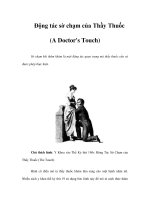Tài liệu When Your Rabbit Needs Special Care Traditional and Alternative Healing Methods pdf
Bạn đang xem bản rút gọn của tài liệu. Xem và tải ngay bản đầy đủ của tài liệu tại đây (9.08 MB, 458 trang )
When Your Rabbit
Needs Special Care
Traditional and
Alternative Healing Methods
Copyright © 2008 by Lucile C. Moore and Kathy Smith
All rights reserved. This book may not be reproduced in whole or in part or in
any form or format without written permission of the publisher.
Published by:
Santa Monica Press LLC
P.O. Box 1076
Santa Monica, CA 90406-1076
1-800-784-9553
www.santamonicapress.com
Printed in the United States
The information contained in this book is intended to help you provide care for
your rabbit; however, this information is not intended for diagnostic or prescrip-
tive purposes. The examples provided were helpful in each particular case, but
a veterinarian and/or alternative practitioner qualified to treat rabbits should be
consulted for your specific concerns. Although the author researched the topics in
this work, the advent of new procedures—as well as future changes to those treat-
ments considered standard at the time of publication—will render some informa-
tion obsolete and further emphasizes the need for consultation with a rabbit-
knowledgeable vet. The author, contributors, editors, distributor, and publisher
are not responsible for any use or misuse of the information in this book, and are
not liable or responsible to any person or group with respect to any loss, illness,
or injury caused or alleged to be caused by the information found in this book.
Santa Monica Press books are available at special quantity discounts when
purchased in bulk by corporations, organizations, or groups. Please call our
Special Sales department at 1-800-784-9553.
ISBN-13 978-1-59580-031-2
ISBN-10 1-59580-031-X
Library of Congress Cataloging-in-Publication Data
Moore, Lucile C., 1952–
When your rabbit needs special care : traditional and alternative healing
methods / Lucile C. Moore and Kathy Smith.
p. cm.
ISBN 978-1-59580-031-2
1. Rabbits—Diseases—Treatment. 2. Rabbits—Health. 3. Rabbits. I. Smith, Kathy,
1954- II. Title.
SF997.5.R2.M66 2008
636.932 dc22
2007041438
Cover and interior design and production by Future Studio
Cover photo by Velly Oliver
CONTENTS
Acknowledgments 8
Preface 9
Introduction
Mr. Tim: An Introduction
to Special Needs and Special Care . . . . . . . . . . . . . . 14
PART I: Traditional Healing Methods
CHAPTER 1
Basic Care I . . . . . . . . . . . . . . . . . . . . . . . . . . . . . . . . . . 20
Lucile C. Moore
CHAPTER 2
Basic Care II 46
Lucile C. Moore
CHAPTER 3
Digestive Ailments 73
Lucile C. Moore
CHAPTER 4
Infections and Infestations 112
Lucile C. Moore
CHAPTER 5
Sprains, Dislocations, Fractures,
and Pododermatitis 141
Lucile C. Moore
CHAPTER 6
Coping with Paresis and Paralysis
in Your Rabbit . . . . . . . . . . . . . . . . . . . . . . . . . . . . . . 158
Lucile C. Moore
CHAPTER 7
Dental Disorders 185
Lucile C. Moore
CHAPTER 8
Other Illnesses and Conditions
Requiring Special Care 199
Lucile C. Moore
CHAPTER 9
Elderbuns 240
Lucile C. Moore
CHAPTER 10
Triage for Large-Scale Rescues . . . . . . . . . . . . . . . . 261
Lucile C. Moore, with Debby Widolf, Shelley Thayer, and
Sandi Ackerman
PART II: Alternative Healing Methods
CHAPTER 11
An Introduction to Alternative Treatments 280
Kathy Smith
CHAPTER 12
Interspecies Communication . . . . . . . . . . . . . . . . . 283
Kathy Smith
CHAPTER 13
Energy Medicine 299
Kathy Smith
CHAPTER 14
Acupuncture and Chiropractic . . . . . . . . . . . . . . . 321
Lucile C. Moore
CHAPTER 15
Healing Through Touch 332
Lucile C. Moore
CHAPTER 16
Alternative Systemic Treatments 348
Kathy Smith
EPILOGUE
Death and Recovery from Grief 370
Lucile C. Moore
APPENDIX I
Tables of Selected Medications Used
to Treat Rabbits . . . . . . . . . . . . . . . . . . . . . . . . . . . . . 397
Lucile C. Moore and Kathy Smith
APPENDIX II
Rabbit Vital Signs . . . . . . . . . . . . . . . . . . . . . . . . . . . 414
Kathy Smith, reviewed by Noella Allan, DVM
APPENDIX III
Traditional Resources for Rabbit Caregivers . . . 416
Lucile C. Moore and Kathy Smith
APPENDIX IV
Alternative Treatment Resources
for Rabbit Caregivers 422
Lucile C. Moore and Kathy Smith
Glossary 425
Abbreviations and Acronyms 427
Contributors . . . . . . . . . . . . . . . . . . . . . . . . . . . . . . . . . . 428
Selected Bibliography . . . . . . . . . . . . . . . . . . . . . . . . . . . 438
Index 443
ACKNOWLEDGMENTS
K
athy Smith, who generously contributed several piec-
es and chapters to this book, wished to thank those
who shared their time and knowledge with her:
I would first like to thank Lucile Moore for the opportunity
to collaborate on this wonderful project. We both want to
thank all the bunny angels—especially King Murray, Dante,
Stormy, Houdini, and Buster—who made sure everything
fell into place as it was meant to.
A special thanks to Dr. Noella Allan, my wonderful
veterinarian, who always makes time for me whether I have
a sick rabbit who needs her care or a writing project that
would benefit from her collaboration and review. I would
also like to thank Dr. James K. Morrisey and Dr. Christine
Eckermann-Ross, both of whom also found time in their
busy schedules to answer my e-mail questions.
Finally, I would like to thank the communicators, res-
cuers, and caregivers who shared their experiences and gave
permission for their stories and/or photos to be included in
the sections I wrote: Vineeta Anand, Meg Brown and Greg
Wait, Dawn Baumann Brunke, Joanna Campbell, Brenda and
Jim Holden, April Jones, Janie Landes, Jeanette Lyerly, Kim
Meyer, Deborah Miles-Hoyt, Molly Sheehan, Kerry Stewart,
Suzanne Trayhan, and Evonne Vey.
PREFACE
M
ost books on house rabbits are written as a result of
the author’s personal experience with a rabbit com-
panion. This book is no exception. I first conceived
the idea of writing about disabled buns after my experiences
with a rabbit who required constant specialized care. He in-
spired me to write an article about caring for special-needs
rabbits, which appeared online, and I then planned to ex-
pand the topic into a book. I also discovered that even my
healthiest rabbits require occasional special care, if only for
a short time after a spay surgery or when recovering from a
digestive upset brought on by stress. I hope that this book,
with tips from many people who have cared for rabbits af-
fected by everything from obesity to permanent paralysis
from a fractured spine, will help others who face giving daily
specialized care to their rabbits.
My focus in this text is on how to actually provide
home care to rabbits with medical problems. But it is my in-
tent to include enough medical information on each disease
or condition that you will be able to understand what is hap-
pening and discuss it with your veterinarian. Only then can
you make the best choices and provide the best possible care
to your rabbit companion. It is beyond the scope of this book
to include all the diseases and conditions that could possibly
affect your companion rabbit, so I have for the most part cho-
sen to include those that you are most likely to encounter.
Rabbit care and medicine, after years in its dark ages,
is progressing rapidly. Periods of swift increase of knowledge
in any field are exciting, but there are also instances where
not everyone is going to agree, and when it may be diffi-
cult to provide one “right” answer. Many differing points
of view may have validity; opinions are often based on per-
sonal experience, and what is successful in one case may not
be in another.
10 When Your Rabbit Needs Special Care
In addition to opinions from veterinarians and alter-
native health care professionals, views of the rabbit caretak-
ers in whose hands rest the actual daily tasks involved in
giving special care to rabbits are included. Again, what hints
they have to give others striving with the same care issues
are based on their own personal experiences as they struggle
to give the best possible care to the companion rabbits they
love. Their perspective may be entirely different from that
of the professionals.
Rabbits are intentionally referred to as “he,” “she,”
and “who” in this book, because those of us who share our
lives with animal companions think of them in this way. For
the same reason, I chose to use the word “symptom” instead
of the more technically correct “sign” when referring to the
visible manifestations of disease in rabbits.
I am aware not all veterinarians will agree with my
decision to include the tables of medications. My reasons for
including them were: 1) The information is widely available
on the World Wide Web and in publications, usually without
the warnings I give; 2) Not all readers are fortunate enough
to live where they have access to a veterinarian experienced
with rabbits, and even the best vets may occasionally make
errors in writing prescriptions. I recommend that a person
always compare a prescription to the range of doses given in
a formulary. If there is a question, a quick phone call to the
vet’s office can resolve any discrepancies and possibly save
the rabbit’s life.
I owe thanks to many people for their help in creat-
ing my share of this book. First and foremost, I owe thanks
to Amy Spintman, board member and educator, San Diego
chapter of the House Rabbit Society, owner of Cats & Rab-
bits & More, founder and moderator of the Disabled Rabbits
Weblist. Without her encouragement and the inspiration
provided by the lives of her special-needs rabbits, especially
Bijou, along with the stories and pleas for help from mem-
bers of the Disabled Rabbits Weblist, this book would never
have come to be.
Preface 11
Secondly, I owe a great debt of thanks to Debby
Widolf, manager of rabbits at the Sanctuary of Best Friends
Animal Society. It was at her suggestion the chapter on tri-
age for large-scale rescues was included. Despite her busy
schedule, Debby also took on the task of reading through my
completed manuscript and offering comments and sugges-
tions. Thanks also to Shelley Thayer, Rapid Response Project
Specialist at Best Friends Animal Society, and to Sandi Acker-
man of Washington, who graciously added her knowledge
and perspective on large-scale rescue.
Lezlie Sage, certified interfaith chaplain and adoption
program administrator at Best Friends Animal Society, will-
ingly tackled the difficult issues of euthanasia and recovery
from grief at my request.
I was thrilled when Kathy Smith, author of Rabbit
Health in the 21st Century and King Murray’s Royal Tail, in-
formed me she was interested in contributing to this proj-
ect. Many thanks to Kathy for her multiple contributions,
especially for writing several of the chapters for Part II, and
for reading over my material and offering her comments
and suggestions. Warm thanks also to writer Jodi McLaugh-
lin for her many informative contributions and to author
Nancy Furstinger for sending a piece on her 15-year-old rab-
bit, Cupcake.
Several supporters of various chapters of the House
Rabbit Society (HRS) encouraged me in this effort. I owe spe-
cial thanks to the following for the stories and photographs
of their rabbits they allowed me to use: Kim and Terry Clev-
enger of the Kansas City, Missouri, Chapter; Margo DeMello,
development director of the national organization; Donna
Jensen, HRS member and former chapter manager who fos-
ters rabbits in the Bay Area of California; and Maria L. Perez,
manager of the Las Vegas chapter.
Members of other rabbit organizations were also gen-
erous with their time and expertise: Stephen F. Guida, volun-
teer with Brambley Hedge Rabbit Rescue; Patti Henningsen,
volunteer with Friends of Rabbits and her own Bright Eyes
12 When Your Rabbit Needs Special Care
Sanctuary; Rebecca Kintner, volunteer with Bunny Magic
Rescue; and Barbara Yule, founder of the North Texas Rabbit
Sanctuary.
Thanks to the following veterinarians for their gen-
erosity in giving their time to answer my questions on vari-
ous aspects of rabbit medicine by telephone, e-mail, and/or
letter: Drs. Mark Burgess, Bill Guerrera, Susan Keeney, Wil-
liam Kurmes, James K. Morrisey, Jamie Sulliban, and Jason
Sulliban. (The fact that they answered questions for me in no
way implies they agree with all the information presented
in this book.) Special thanks to Dr. Kurmes for meticulously
going through my entire part of the manuscript searching
for any medical errors.
I am grateful to the expert practitioners who contrib-
uted to my alternative methods of healing chapters: Chan-
dra Moira Beal, George Belev, Marnie Black, Anita DeLelles,
and Greg Wait.
I also owe thanks to the many rabbit caregivers (some
members of organizations such as the HRS, some not) who
gave me permission to share their care tips or photos so that
others might benefit: Betsy Bremer, Meg and Buster Brown,
Shannon Cail, Marion Davis, Melissa Epperson, Alexandria
Fenner, Laura and Peter Franco, Becky Hawley, Jennifer
Heaton, Morgan Heller, Jen Hendricks, Stacey Huitikka, Ar-
lette Hunnakko, Ronie Lawrence, Karen Cole Leinenkugel,
Delores Lowis, Jeanette Lyerly, Joe Marcom, Rachel Marek,
J. Medawar, Joseph Nobile, Missy Ott, Suzanne Pani, Angela
Percival, Susan Robbins, Theresa Romaldini, Lynn Sagra-
moso, Sharon, Julie Sherwin, Renee Stratton, Dawn Stuart,
and Joanne Wilcox. Your love for and devotion to your rab-
bits is always evident!
Special thanks to Dave Stewart for his constant en-
couragement and support during this project. How many
people would leave work and drive over 500 miles to pick up
a rabbit to get him to a vet in time?
Finally, I owe thanks to the many wonderful rabbits
who have shared and do share my home: FBR (Fierce Bad
Preface 13
Rabbit) Bunnyman, Muffy, Sweetie Pie, Timothy (Mr. Tim),
Anthony, Funny Face, Binky, Snugglebiter, Angel-bunny
(aka Beulah), Magic, Pixie, Fuzzy Wuzzy Fuzzbug, Rapunzel,
Dolly Doodle, Phantom Elvis, Ruby, Siegfried, and Roy.
Lucile C. Moore, PhD
INTRODUCTION
Mr. Tim:
An Introduction to
Special Needs and Special Care
The baby rabbit was barely visible on the bottom of the hay-filled
box at the back of the barn. As my eyes adjusted to the dim light
I could see that his tiny body was shaking. He appeared so small,
so delicate; I was afraid even to touch him. I looked at my friends,
my questions in my eyes.
“I was going to euthanize him because he has a lot of
congenital abnormalities,” Sharon explained to me. “But my hus-
band fell in love with him and begged me to find him a home. I
couldn’t trust just anyone to give him the special care he needs, so
I thought of you.”
Sharon carefully lifted the tiny rabbit from the box and
handed him to me. For some reason I held the frail body as I
would rarely hold a rabbit—upside down, cradled in my arms. His
trembling stopped immediately and he relaxed against my chest
with a visible sigh. My heart contracted and a fierce protectiveness
filled my being.
“Did you see that? Did you see how he looked at her with
instant total trust?” my friend Dave marveled. “He knows he is
safe now. He knows he has found a home.”
That was my introduction to the world of special-needs
rabbits. For the next several years, my life would revolve around
the tiny little tortoise Holland Lop. Answering his needs would
fill my every day, and his incredibly strong spirit would dominate
that of every other rabbit in my home. He lived three wonder-
fully happy years, and when he died, he died in my arms. For his
burial, I wrapped him in a hand-stitched velveteen heart quilt
given to me for that purpose by a friend who understood the mag-
nitude of my loss. A lock of my hair rested on his breast.
This book is dedicated to you, Mr. Tim, and to all those
Introduction 15
human companions who meet the difficult and rewarding chal-
lenge of caring for special-needs rabbits.
M
r. Tim was a true special-needs rabbit; a rabbit who
required special care every day of his life. But any
rabbit can become a rabbit that requires support for
a short time. The bun might become ill, break a limb, have
serious digestive troubles, or simply live long enough to de-
velop some of the infirmities of old age. Occasionally, a rab-
bit may not come through a routine surgery as expected and
suddenly require special care. Nor is a physical problem nec-
essary for a rabbit to require extra support. Sometimes rabbits
need special care because of emotional problems stemming
from early mistreatment.
Usually the need for special care is temporary, last-
ing only long enough for the rabbit to recover from a
transitory condition. Sometimes, though, the need is
permanent. Most caretak-
ers of permanently disabled
rabbits don’t set out to be-
come caretakers. A perfectly
healthy rabbit may become a
disabled rabbit in an instant
if the spine is severed in a
cage accident or from mis-
handling. Other times, rab-
bits have serious congenital
problems that may not show
up until months or years
have passed.
Most of us can cope with a temporary need to give
a rabbit extra care if we are able to find the information to
help us do it correctly. Sometimes all it takes is a day or so of
monitoring a rabbit’s temperature and food intake, and add-
ing a light blanket to the cage for warmth. Or we may need
to give an oral medication for a few days. We can probably
Any rabbit may require
special care at some time.
16 When Your Rabbit Needs Special Care
even cope—though we may
be a little more hesitant—if
we find we need to adminis-
ter subcutaneous fluids for a
week.
Providing such care
for the life of the rabbit is a
different matter entirely. If
you are suddenly confronted
with having a rabbit that re-
quires lifelong special care,
one of the first questions to
ask yourself is whether you
will realistically be able to
take on the commitment. Caring for a permanently
disabled rabbit requires a great investment of time, money,
and emotion. If you have cared for a healthy house rabbit,
quadruple or quintuple the time you spend on it for an esti-
mate of the amount of time it will take to care for a severely
disabled house rabbit. Does your job and family life permit
such an investment? Can you take the emotional upheaval
of caring for a permanently disabled rabbit? Many such rab-
bits experience widely varying ups and downs that can be
hard to take. Just when you feel the rabbit has turned the
corner, he/she slides back down—over and over and over
again. Finally, do you have the financial resources to provide
permanent special care to a rabbit? Special daily supplies and
food are often required, not to mention veterinary costs and
medications.
If you can’t answer the above questions in the affir-
mative, you may want to think before taking on the care of
a severely disabled rabbit. The twin necessities of earning
money and caring for one’s human family may simply make
such a commitment impossible for many, however much
they may wish to take it on. If your current circumstances
don’t allow you to take on such care and you find yourself
with a rabbit requiring special assistance, contact your local
Peanut is a permanent
special-needs rabbit.
Introduction 17
House Rabbit Society (HRS)
1
chapter or rabbit rescue organi-
zation. They may be able to find someone who can.
But if you do answer in the affirmative, prepare your-
self for a life-changing experience. Caretakers often develop
remarkably close relationships with their special-needs rab-
bits. Donna Jensen, who became a member of the House
Rabbit Society (HRS) in 1992 and has fostered rabbits with
special needs ever since, comments, “Nothing is more spe-
cial than caring for them. It is very rewarding, and I always
say it is an honor to serve. They really, really want to be here,
so you say ‘Yes, I will do this for you.’”
Maria Perez, manager of the Las Vegas chapter of the
House Rabbit Society, sanctuaries 16 medically compromised
rabbits. “The most rewarding thing is that I learn something
of value from them every day,” Maria states. “They indeed
never cease to amaze me.” Although she loves all the rab-
bits who come to her, it is evident that one, Chloe, holds
a special place in Maria’s heart. “The veterinarians say that
she is a miracle—with all of the adversity she has overcome
and medical challenges, yet she remains the happiest soul
I have ever known.
She is my life coach.
‘It’s OK Mom, tomor-
row is another day,’
she’ll whisper when
I’m blue. She is a joy
to my heart each and
every day.”
S t e p h e n F .
Gu ida , a volunteer
with Brambley Hedge
Ra bbit Rescue , has
shared his life with
several rabbits need-
1 The House Rabbit Society is an all-volunteer, non-profit organization dedicated
to rescuing abandoned rabbits and educating the public about rabbit care.
Intrepid Chloe enjoys life
despite her special needs.
18 When Your Rabbit Needs Special Care
ing special care. “I have received so much from caring for
my special-needs bunnies,” Steve comments. “For one, the
complete and total trust they place in you is very beautiful
and heart-warming. The love they show every time you care
for them is something that never grows old. Curiously, my
special-needs bunnies have always seemed to be my happiest
bunnies, taking such complete joy in a simple brushing, a
pat on the head, a scratch on the ear, or something that any
‘normal’ rabbit would not think twice about.”
Lucile C. Moore, PhD
PART I
TRADITIONAL
HEALING METHODS
M
ost of the time spent in giving special care to a rabbit will
be in providing the essentials. Rabbits must be kept:
• Clean and dry
• Groomed
• Comfortable
• Hydrated
• Fed
• Pain free
Creating a safe, comfortable, and clean environment
for the rabbit requiring special care is the first necessity. This
may be a relatively simple task in the case of a rabbit recover-
ing from a spay surgery, or it may be a difficult challenge, as
in the case of a rabbit that has a broken spine or head tilt. In
either situation, location is the first concern. The rabbit may
be disinclined or unable to move much on his own, so care
must be taken to ensure his personal space will be safe and
comfortable. The rabbit should be in a spot where he is not
too near a heat source, cold draft, or fumes. An area where
the rabbit will be able to watch some activity is preferable,
as you do not want the rabbit to feel isolated, but too much
noise or activity could be stressful.
Rabbits needing special care are not unlike humans
CHAPTER 1
BASIC CARE I
Lucile C. Moore
Basic Care I 21
who are ill; things that might not stress them at other times
may when they are not feeling well. Loud noises could be
stressful, so be sure the bun is not too close to a television
or radio. Another possible source of stress to an ailing rabbit
is the presence of other animals. Although many rabbits get
along well with household cats and dogs, this is learned be-
havior. When a rabbit is ill, he may become stressed by the
presence of these “predators.” Do not assume because of your
affection for the cat and dog members of your family that
this cannot happen.
It is always necessary to keep a rabbit’s space clean,
and this is even more critical for the rabbit needing special
care. For general cleaning, the best choice is white vinegar
or a dilute solution of an iodophor such as Betadine
®
, Veta-
dine
®
, or Vanodine
®
. Iodophors are good, inexpensive, gen-
eral-purpose disinfectants with bactericidal properties. They
are safe for cleaning areas where rabbits live as well as their
food and water dishes and bedding. Follow dilution instruc-
tions carefully, as their effectiveness depends upon it. A di-
lute solution of chlorine bleach (one part bleach/ten water)
can also be used, and is an effective disinfectant, but you will
need to keep the rabbit away from the fumes and not return
him to his pen until surfaces are thoroughly dry.
Where transmission of a disease is a concern, you
may need to keep a rabbit in a separate room and observe
strict sanitation. Wash hands thoroughly before entering
and immediately after leaving the room and have a foot-
bath at the door to step in on your way in and out. Fold an
old towel in the bottom of an inexpensive plastic dishpan,
and pour in enough of a rabbit-safe disinfectant to wet the
towel. Then simply step into the dishpan before entering
and exiting the room.
Bedding
If your rabbit requires special care only temporarily and is
not incontinent, the only change you may need to make to
Basic Care I 2322 When Your Rabbit Needs Special Care
Basic Care I 2322 When Your Rabbit Needs Special Care
his bedding is to add a
soft towel or blanket for
extra comfort. Rabbits
who are still recovering
from anesthesia and
rabbits who have had
areas of fur shaved off
for surgery may need a
light blanket over them
or b un ch ed a ro un d
them to help conserve
body heat.
Bedding for rab-
bits who are permanently incontinent, paralyzed, or suffering
from other debilitating disabilities requires more ingenuity.
Some caretakers of paralyzed rabbits use large cat beds (not
cedar-filled, as the fumes from the shavings could have nega-
tive effects on rabbits), line them with a puppy pad or dia-
per, and place a soft towel or piece of synthetic sheepskin
on the top. These beds have the advantage that they can be
carried from room to room, and allow the caregiver to keep
the rabbit with them most of the time. However, they may
not be feasible with larger rabbits or rabbits who have not
lost all their mobility.
Depending upon the particular disease or condition
the rabbit has, manufactured housing can provide a safe,
easy-to-clean living space. A rabbit cage on a high wheeled
base with a top opening can be very useful for providing
intensive nursing, as can a rabbit “condo” with a hinged top
(Appendix III).
Many caretakers of rabbits who have lost their mobil-
ity create a space for them by placing layers of bedding in an
area set off by indoor pet fencing or in a purchased baby crib
or playpen. The size of the pen needed will vary according to
the size of the rabbit, but in general, a space about three feet
by four feet is adequate for one rabbit who has lost mobil-
ity. The perimeter can be made from baby gates or a small-
Bijou relaxes comfortably
in her donut bed.
Basic Care I 2322 When Your Rabbit Needs Special Care
Basic Care I 2322 When Your Rabbit Needs Special Care
animal exercise pen. You will need to be able to access the
pen easily, as you will be replacing the bedding and tending
to the rabbit frequently.
A waterproof barrier such as a piece of plastic or a
bed pad for incontinent persons is placed on the floor of
the pen. The next layer can be a piece of egg crate foam or
sheets of large plastic bubble wrap. Both of these will help
to prevent the formation of pressure sores, which is always
a concern in rabbits with limited mobility. Next, a puppy
piddle pad, diaper, or incontinent pad for humans adds an-
other waterproof barrier. Absorbent towels, old T-shirts, or
synthetic sheepskin makes a comfortable and absorbent top
layer. The hands-down favorite faux sheepskin with mem-
bers of the Disabled Rabbits group on Yahoo! is that from
Palace Pet Beds™. This comes in various sizes and colors, and
caretakers who use it claim it can withstand repeated wash-
ings. Less expensive alternatives for faux sheepskin include
“sheepskin” mattress covers that can be cut into pieces for
use as bedding, and synthetic sheepskin of varying thick-
nesses that can be purchased by the yard at fabric stores.
Other beddings that can be used in creating an area
for special-needs rabbits are dog-crate liners and inexpensive
carpet samples that can be used until they are soiled and
then thrown away.
Paralyzed rabbits will also need to have something in
their pen to rest their head on. It is important to keep the
front quarters of the rabbit elevated and in a more natural
position. This can help prevent lung problems and usually
makes the rabbit feel better both physically and mentally. A
purchased donut bed can provide this support for a paralyzed
bun, or you can make your own supports by rolling up soft
cotton fabric, mattress pads, or towels.
Toys
Rabbits needing special care are as intelligent and curious
as any healthy rabbit, and will need toys and other items









